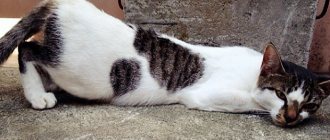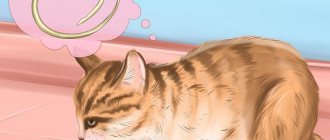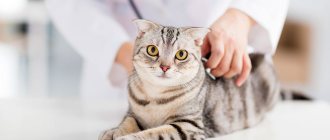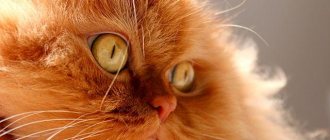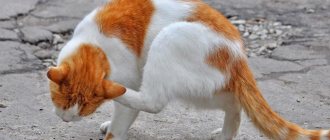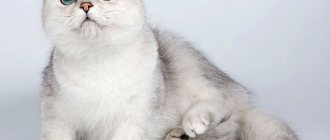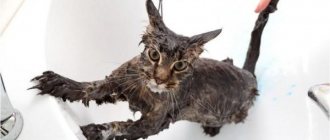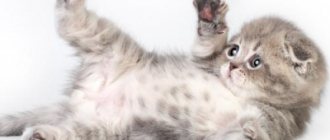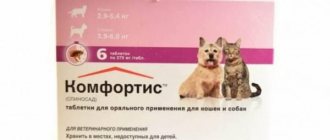Examination of the animal's ears
This procedure should be performed from an early age, which will allow the pet to get used to it and will not cause a negative reaction in him. When examining, pay attention to the presence of the following factors:
- sulfur and pollution;
- bloody spots;
- unpleasant odor;
- tumor formations;
- hyperemia and inflammation;
- scratches and scratches.
In order to properly carry out the examination, you need to carefully bend the ear, slightly turning it inside out. The inside must be clean. The passage is pale pink. If there is a large accumulation of sulfur, the passage should be cleaned. But, if in addition to it, you saw something else, contact your veterinarian to be on the safe side.
Before performing the manipulation, it is advisable to play with your pet so that he does not perceive it as something bad, after which you can give him a treat.
Removing earwax with a cotton swab
Independent ear toilet
As noted above, ears do not require special cleaning. According to the American Academy of Otolaryngology, wax removal should only be done when plugs form and unpleasant symptoms occur.
Sulfur removal sequence:
- Drops to soften sulfur or a solution of hydrogen peroxide (3%) are taken into a warm pipette.
- Lie on your side and carefully pour/drip the solution into your ear.
- Leave for 5-7 minutes.
- Press a napkin to your ear and tilt your head.
- Use a small bulb to rinse the ear canal with warm water (~37°C), pulling the earlobe up and out.
- Blot the ear with a napkin to remove any remaining water.
The procedure can only be performed on a healthy ear, and very carefully. Perforation of the eardrum and inflammation are contraindications for getting rid of wax on your own. A doctor will help identify the pathology: depending on the symptoms, he will conduct an additional examination.
To avoid injury or other complications, it is best to carry out cleaning in a medical facility. At the clinic, the otolaryngologist will perform irrigation - washing the ear canal with a stream of water under pressure. Doctors use a special syringe or electronic irrigator with pressure control, directing the stream at different angles. In the case of dense wax, the doctor will examine the ear canal using a mirror to ensure that the ear is completely clean. If irrigation is contraindicated, the ENT doctor removes the sulfur plug using special instruments (probe, otoscope and others).
For detailed advice on the procedure, please contact otolaryngologists at the President-Med medical centers
Why does dirt appear in a cat's ears?
The auricle has a complex shape. Sulfur secretions, which are present normally, perform a protective function for the middle ear. But if they are present in excess quantities, they can become a favorable environment for the development of pathogenic microorganisms.
Dust particles, small hairs, dirt constantly get into the ears, and flakes of dying skin also accumulate. In response to this, a protective substance is produced - sulfur, which creates an obstacle to the penetration of contaminants.
Without proper care, wax plugs may form or inflammation may develop, which in special cases will lead to complete or partial hearing loss, as well as changes in the functioning of the vestibular apparatus. And hearing for them is the most important factor, because the sensitivity of a pet’s ear is several times higher than that of a human.
Required accessories
Need for cleaning
Should cats' ears be cleaned and why? The hearing aid has a very complex structure, hence there are so many practical questions.
Like other mammals, cats have glands that produce a special secretion - sulfur. This is a natural process necessary to protect the middle ear from dust, foreign particles and harmful microorganisms. Sulfur is released naturally during chewing of food, and the animal itself removes its excess while washing.
The process does not always go smoothly, and some individuals require the help of the owner.
Hygiene
Often the secretion that is not released accumulates, forming sulfur plugs, leading to hearing impairment. By putting pressure on the eardrum, the plug provokes unpleasant sensations in the form of pain, nausea, and dizziness.
It should be remembered that the auditory canal, in addition to the perception of sound, performs another function - it is responsible for the position of the body in space and the ability to maintain balance. In other words, it is closely connected with the vestibular apparatus, so if cleaning is not carried out on time, it can lead to deterioration of coordination.
Hygienic cleaning is performed if necessary - if the owner of the animal notices accumulations of wax in the ear. The ear needs to be examined weekly: if there is a dark or yellowish coating, it is carefully removed without going deep.
Prevention and treatment of diseases
The first examinations must begin at an early age, trying to accustom the kitten to the procedure, since it must be performed constantly. If you do not regularly inspect and clean, parasites may appear in the ear canal - wax is a good breeding ground for ear mites.
The increased attention of the four-legged animal to its “locators” can be considered an alarm bell. The animal begins to constantly itch, trying to get something out of the ear canal, or shake its head. If you observe such symptoms, take your mustachioed friend to the veterinarian immediately.
When treating ear diseases, you need to clean them 1-2 times a day with special products. The veterinarian will prescribe a regimen of procedures in accordance with the identified pathology.
Frequency of procedure
The amount of sulfur produced is influenced by many factors: breed, diet, activity, environment. Since the cat's “locator” is very sensitive to touch, too frequent intervention can cause unpleasant associations. Therefore, owners are worried about how often to clean their cat’s ears so as not to cause harm and not miss the onset of the disease?
There is no consensus among veterinarians. A lot depends on the breed of the pet - for example, hairless cats do not have hairs in their shells, so they produce an excess amount of sulfur for better protection.
Fold-eared breeds also need close attention - their ear canal is covered, and therefore ventilation is difficult. Also, increased secretion of sulfur is observed in older animals, individuals with chronic diseases, and in cats who have suffered from ear mites.
Accordingly, for such pets, inspection is carried out every two to three days, and cleaning is done every three to four days. For other breeds, an inspection once a week is sufficient. Do not confuse examination and cleaning - it is quite possible that your pet will only need intervention once every 3-4 months.
Step-by-step instruction
If your pet strongly resists, categorically refuses to undergo cleaning, breaking free from your hands, then it is better to secure it with a towel.
Stages of implementation:
- Warm the lotion in your hands before starting so that the cold drops do not cause discomfort.
- Shake the bottle vigorously for 10-15 seconds.
- Open the bottle and drop 2-3 drops of the product into the passage, tilting the animal's head to the side.
- Using circular movements, massage the base of the ear to distribute the liquid over the entire surface.
- Release your head so Fluffy can shake it. This will allow the dirt to come off better.
- Soak a cotton pad or swab in lotion and wipe the inside surface with it, paying attention to each fold.
- If the ear is completely cleared, then proceed to the second one.
Of course, it is better to entrust the entire process to a veterinarian, but this is not always possible. If there is a lot of dirt, then home cleaning will not be enough.
Cleaning with a cotton pad
How to clean and rinse cat ears: tools and liquids
The cat's ears are cleaned of accumulated dirt and earwax using a swab, disk or cotton swabs . A soft cleaning surface is moistened with mineral oil and Vaseline.
These products help remove dried lumps without pain. Instead of Vaseline, you can use a little baby cream, a drop of peach or almond oil (purified, cosmetic).
Please note: liquid or fat should not drip from the cotton wool - there is no need for excessive wetting.
Rinse the ear with distilled water and saline solution in cases where it is necessary to clean the ear of blood and foreign substances. At home, they use an Esmarch mug, a large 20 ml syringe without a needle, and large bottles with a spout. The stream of water should not enter the ear canal, so the animal’s head is tilted slightly.
It is not recommended to use a match with a piece of cotton wool wound:
- Stiff - any wrong movement can cause pain.
- Short – it’s inconvenient to work.
After cleaning with a greasy product, wipe the ears with a dry cotton swab, absorbing any remaining cleaning product. If radical measures were taken—deep rinsing—the final step is to carefully blot the surface with a water-absorbing napkin or soft towel.
How often and with what to clean
The frequency of manipulation depends on the breed, health and other nuances. For example, for sphinxes, treatment should be performed once every 5-6 days.
For other breeds the interval is from 7 to 30 days. In addition, if the animal is an exhibition animal, then the treatment is carried out before each exhibition.
To carry out, you should prepare the following items:
- towel for fixation;
- a special cleaning product that can be bought at a veterinary clinic or a chlorhexidine solution. It is strictly forbidden to use alcohol-based solutions or soap solution;
- cotton pads or swabs for newborns, or clean dry wipes;
- You can use a flashlight.
Structure of a cat's ear
What not to do
It is necessary to perform manipulation only on the visible part; attempts to penetrate deeper will only do harm.
There is no need to use folk remedies or self-prepared solutions that can dry out the epidermis and cause allergies.
Some breeders perform it to perfect purity. This is far from correct. Earwax should be present in moderation.
Also, do not use self-made devices. Is it dangerous. Leads to injury and infection.
Indications and contraindications for whitening
Your teeth should have a fairly strong and thick layer of enamel. Only a dentist can determine its condition. The yellow coating should be superficial. If it is deep, then teeth whitening methods will not bring you the desired result.
Contraindications:
- Increased sensitivity of teeth;
- Allergy to hydrogen peroxide;
- Caries;
- Damage to enamel.
So, if the dentist has determined that there are no contraindications to the procedure, you can perform home teeth whitening, saving time and money, but always proceed from the principle of “do no harm.”
When to contact a veterinarian
If during examination you find pus, crusts, or bumps, then you need to see a veterinarian, as this indicates the development of a specific disease.
In addition, you need to visit a veterinarian if you regularly do preventive cleaning, but do not observe the desired effect. Sulfur, impurities constantly accumulate, an unpleasant odor has appeared, during the procedure there are purulent traces on the cotton pad, or the cat is restless, shaking its head, or itching. These symptoms are a sign of a serious illness.
Ear cleaning at the vet
What is needed and the price for what is needed
A cotton pad is used to clean the ears. There is no need to use cotton swabs - they can cause serious damage. Gauze is also not suitable as it can damage soft tissue.
Before wiping the ear, the cotton pad must be moistened with lotion or other disinfectant. There are many options for cleaning.
Cat ear cleaning lotion
Cleaning lotion
The most affordable and popular product for this hygiene procedure. Another plus is the wide range of products. Most often, it is the lotion that pet owners choose as a means for treating their pet’s ears.
The price range is 150-700 rubles per package.
Ear hygiene drops
Drops
Ear hygiene drops are less common than lotion. In most cases, drops are a veterinary drug for the treatment of fungal and parasitic diseases. However, there are also disinfectants that leave no traces behind.
Ear drops contain substances that dissolve wax and other contaminants in the ears. As a rule, such products are used regularly, including after long walks or after bathing at home. The price for them is about 1200 rubles.
Cat ear powder
Powder
Powder is a means for regular treatment; its properties help eliminate itching and other unpleasant sensations in your pet. Bactericidal powder is very often used by owners of show animals.
The product is often recommended by veterinarians for treating ears during inflammatory processes. The average cost is 200-500 rubles.
The powder is also used to remove large amounts of hair on the inside of the ear. To do this, it is applied to the hairs and smoothly distributed with a cotton swab. After this, the hairs are pulled out, and the remains are carefully removed with a cotton swab. Antibacterial powder is more often used by dog owners than by cat owners. This product is one of the favorites among animal groomers.
Cat ear cleaning gel
Gel
There are so-called gels for cleaning the ear canals of cats. Their peculiarity is that they form a liquid upon contact with the skin, washing away all the dirt from the ears. After use, the gel does not leave any greasy stains.
To achieve greater effectiveness, apply the product to a cotton pad and wipe the pet’s ears with it. To clean the hearing aid, a small amount of gel is squeezed into it.
After this, the ear must be massaged. The pet itself will push all the dirt out; they are removed with a dry cotton pad.
Cleansing gels are rare and require significant expense. For 100 ml you will have to pay about 500-700 rubles.
Spray used to clean ears
Spray
Sprays are used not only for preventive purposes. Their use is prescribed by veterinarians if a pet is diagnosed with otitis media and other inflammatory processes in the ear.
The product contains substances that dissolve sulfur and other dirt. They also normalize the condition of the skin and have an anti-inflammatory effect.
The use of the spray is practically no different from other drugs. First, it is applied evenly throughout the ear, which is then gently massaged. The intensity of the massage depends on the general condition and pain. Then use a dry cotton pad to remove dirt from the inside of the ear.
Hygienic sprays rarely appear on the windows of pet stores and veterinary pharmacies. However, they are not expensive. Their average cost is 150-250 rubles per 100 ml.
Napkins
Wet germicidal wipes are very easy to use. They already have all the necessary substances for cleansing. It is enough to wrap your finger in them and carefully remove wax and other dirt. The wipes have antiseptic properties and gently cleanse the sensitive skin of the ear.
Wipes are available for the ears and eyes of cats. The availability and convenient use of this product makes it an ideal option for those who like to travel long distances with their pets. The price of napkins is completely different: for a package of 15-20 pieces you can pay 20-200 rubles. Packages with a large number of napkins are significantly more expensive: they are sold for both 200 and 700-800 rubles.
Battery operated ear cleaner
Special gadget Ear cleaner
Special ear cleaning devices are suitable not only for adults, but also for small kittens. The device is equipped with a backlight and a silicone nozzle that reliably removes all accumulations of sulfur.
The nozzle is specially made in the form of a spiral to reduce the likelihood of injury to zero. It also ensures the safety of the procedure even for small pets: kittens, puppies and rabbits. After use, the nozzle is thoroughly rinsed under warm water.
The device is gradually gaining popularity. It is not sold in all pet stores. On average it costs about 150-1000 rubles. As a rule, the kit already includes one battery.
The most common ear problems
In general, the presence of abundant secretion of glands may indicate the development of pathology, which will subsequently develop into a disease.
Hematoma
If the animal shakes intensely or scratches its ears, a blood vessel may rupture and a bruise may form.
Causes: trauma, forceful shaking of the head, regular calculations due to infestation by ticks, fleas, allergic reaction or middle ear infection.
Such hematomas require immediate specialist intervention.
Otodectosis
The main manifestation of tick-borne infection is behavioral changes: intense shaking of the head, scratching of the ears. Also considered symptoms of the disease are:
- reddish or brownish discharge;
- bleeding;
- on the inner surface you can see a crumbly substance that resembles ground coffee;
- scratches;
- smell;
- twitching;
- otitis externa
Otitis externa
This is an inflammation of the external auditory canal, often caused by an infectious etiology.
Signs:
- head shaking;
- scratching in the upper head part;
- discharge and unpleasant odor;
- hyperemia;
- swelling;
- behavior change;
- soreness.
Solar dermatitis
As a rule, albinos, breeds with white ears and noses, and sphinxes are affected. The reason is the lack of melanin and protective hair in certain areas of the body. The ears, eyelids, and nose are most often affected. The first manifestation is considered to be moderate hyperemia and hair loss. Next comes thickening of the skin and itching, causing multiple scratching and bleeding. If left untreated, it develops into squamous cell carcinoma.
Sulfur plugs
Brown plaque is not always a symptom of a disease. This may indicate a sulfur plug that has formed due to insufficient care. By themselves, they do not cause discomfort, but, as a rule, lead to an inflammatory process.
They are treated with a special solution that dissolves them. After the plug comes off, the area is treated with Chlorhexidine.
To sum it up, we can say that a cat's ears are not only for hearing, but also for balance. That is why they require special attention. Knowing how to properly clean your cat's ears can prevent the development of serious diseases, including hearing loss. By following the recommended instructions, you will be able to properly carry out hygienic care.
Video from a breeder of the Burmese breed How to properly clean a cat’s ears at home
Cleaning the ears of adult cats
In aging female cats, the ear canal gradually narrows, the outflow of wax weakens, and the male cat may rub its ear with its paw or lick it until it becomes bald. If the inside of the ear does not cause concern, then this is just an attempt to get rid of the itching that occurs due to dryness.
Consult a knowledgeable specialist, he will tell you how to alleviate the situation, because... It will no longer be possible to restore the secretion of the ear glands in an elderly pet.
Another “dangerous” age is early adolescence. You need to be very careful about keeping your kitten's ears clean! Disorder of the hearing aid in almost infancy can lead to irreversible damage to motor functions, because the hearing aid is also an organ of balance. Such damage can forever leave the baby semi-disabled with tangled legs and convulsive twitching of the head.
After the examination, if nothing suspicious is found that requires a doctor’s intervention, you can begin cleaning.
